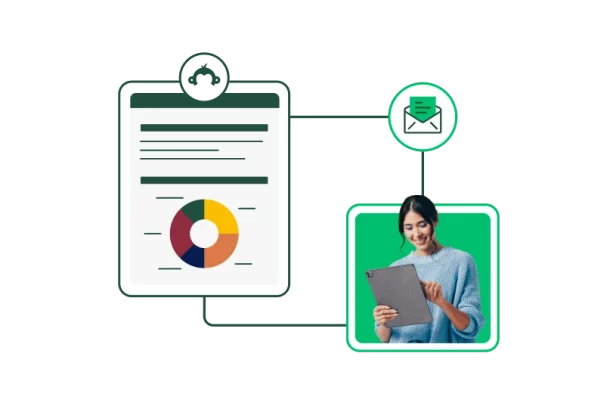How to deploy an employee engagement survey

Employee engagement is critical to business success. It’s an important metric because an engaged employee is more committed to helping a company reach its goals.
However, with the shifting dynamics of today's workplace, traditional employee engagement strategies—pizza parties, office potlucks, and team off-sites—might no longer cut it. The move to hybrid or virtual workplaces and remote employees means that companies are looking for creative strategies to keep their workforce motivated and connected.
How can HR teams measure employee engagement in such a dynamic working landscape? The answer is simple: Talk to your employees. Ask them what they think with an employee engagement survey. Read on to learn more about using feedback to measure employee engagement and see if your strategies are working.
What is employee engagement?
Engagement engagement refers to the emotional and professional connection an employee feels about their company—and how invested they are in their work. Engaged employees are more like to report higher job satisfaction and better job performance. Employee engagement also drives higher employee retention and reflects a positive overall employee experience.
Engaged employees believe they do meaningful work, feel valued, and understand the company's overall goals and how their role contributes to its success. Actively engaged employees boost the company’s competitive advantage and drive long-term success.
Why is employee engagement important?
The most obvious way high employee engagement pays off is by supporting employee retention. The true value of retention—and, conversely, the cost of employee turnover—can be difficult to gauge, but organizations of all sizes should presume it is substantial. According to Gallup, the cost of replacing an employee can range from one-half to two times the employee’s annual salary.
Employee engagement vs. employee satisfaction

Employee engagement and employee satisfaction often get used interchangeably, which can be particularly confusing in survey design. While there is some overlap in the factors that drive engagement and satisfaction, the two are distinct.
An employee satisfaction survey measures how employees feel about their jobs and work. An employee engagement survey measures three criterion:
- Employee perception of the organization and its overall mission
- How they feel being a part of the organization
- Their investment in broader and long-term success beyond their day-to-day routines
How does a company measure employee engagement?
If employee engagement promotes corporate success, then measuring engagement is paramount. But how does a company measure engagement and understand what drives it?
The answer lies in the employee engagement survey.
What is an employee engagement survey?
An employee engagement survey determines engagement and motivation among employees. Employers identify this motivation through employee engagement survey questions that collect feedback and provide specific quantifiable and non-quantifiable data points.
Employee engagement survey responses provide actionable insights to increase employee engagement by revealing areas for improvement. hey can also add great context to other employee surveys like employee Net Promoter Score® (eNPS).
But it begins with an action plan.
Developing an action plan
Step 1: Create a framework for measuring success
Articulating specific goals
The goals of your specific employee engagement program can vary, but there are some common goals that are important for most organizations. These include increased employee productivity, retention, and customer satisfaction.
Identifying the tasks required to achieve goals
Break down employee engagement goals into a set of concrete deliverables. A few ideas: launch new training and development initiatives, offer flexible working arrangements, or provide DEI opportunities. For each deliverable, establish a regular feedback program so you can collect data on employees' participation and value.
Measuring progress
Make sure your tasks are tied to your goals by measuring progress. Is participation in training driving improved employee productivity? Are your work-life balance programs improving retention?
Making changes to drive improvement
Give your employee engagement initiatives some time to take hold, then check back with your workforce on what’s working. Eliminate or replace the programs that don’t deliver results, and continue to improve on what’s well received.
Step 2: Align key stakeholders
Before designing your employee engagement survey questions or even announcing the initiative, however, everyone leading the project needs to be on the same page about some key considerations.
Come up with a communication plan to keep everyone in the organization up to date about the initiative as it proceeds. Leverage internal research and analytics tools for measuring and monitoring progress against goals.
Step 3: Set achievable goals
- What areas identify where improvement will drive gains in employee engagement?
- How well do those areas align with current strategic initiatives?
- How much is the organization prepared to invest in employment engagement - initially and in the future?
- Are leadership and management teams on board and on the same page regarding delivering on promises?
Step 4: Develop and implement a communication plan
Does the plan recognize and distinguish between long-term company goals and those that are more rapidly achievable? It is also worthwhile to determine beforehand who should own the specific actions resulting from the survey.
3 tips for launching an employee engagement survey

1. Start with the right questions
You should tailor your employee engagement surveys to your organizational structure and culture. There's no prescribed length that is optimal for every company, but make sure you're intentional with the employee engagement survey questions you're asking. It can be helpful to think about the various drivers that may be impacting engagement.
Organizational drivers
- Leadership's commitment to making it a great place to work
- Leadership's commitment to making it a great place to work
- Trust in leaders to set the right course
- Belief the organization will be successful in the future
- Understanding how one’s own role fits into future plans
- Leaders who value people as the company’s most important resource
- Organizational investment in making employees more successful
Management drivers
Management drivers pertain to employee relationships and experiences with supervisors and managers.
Other drivers
Other drivers that correlate with engagement include:
- Good partnerships with supervisors
- Access to equipment necessary to do a good job
- Authority needed to do a good job
- Freedom to make work decisions
2. Include open-ended questions
Regardless of which which drivers you measure, one element should figure into every employee engagement survey: open-ended survey questions.
Sometimes called open-text questions, these survey questions invite survey employees to share, in their own words, their experience, satisfaction, perception of the company, and more.
Open-text employee engagement survey questions can be cumbersome to analyze, but when used judiciously, they are invaluable because they can help illuminate the “why” behind the numbers. Companies can then strategically manage the resulting information like other key metrics using an action plan.
3. Make sure your survey addresses the unique needs of your organization
Every organization is different and understanding your employees is a big part of successful engagement. You may have a company that is completely committed to a virtual workplace, in which case, your questions may need to be more focused on how to engage remote employees. Or you may have a young workforce that needs the support of in-office perks, such as a dining area where they can collaborate or leadership training programs that will support their career growth.
Other questions to consider:
Do employees want more job security or a career development opportunities? Is the compensation and benefits package provide enough of an incentive to stay engaged? Is your culture inclusive and supportive?
Get started with employee engagement
We’ve created an employee engagement survey template that will give you a head start on understanding your employees' commitment to your company and their job satisfaction. Get started now.
Net Promoter, Net Promoter Score, and NPS are trademarks of Satmetrix Systems, Inc., Bain & Company, Inc., and Fred Reichheld.
Discover more resources

Attract, engage, and retain top talent with data-driven insights
Create powerful HR surveys with SurveyMonkey to gather feedback, boost engagement, and improve workplace culture. Streamline HR processes with customizable templates.

Why are surveys important in research?
Surveys are important in research because they offer a flexible and dependable method of gathering crucial data. Learn more today.

Job application surveys
Survey job applicants online to get a good understanding of your recruitment process strengths and weaknesses. Free templates and survey advice, sign up today!

HR Survey Questions: 80 Examples & Best Practices
Discover 80 HR survey questions, best practices, and tips for success to improve employee engagement.